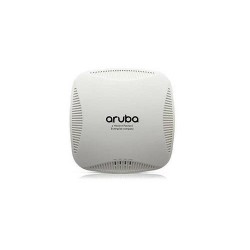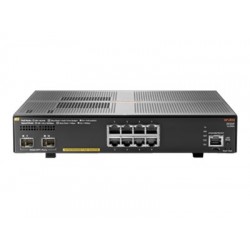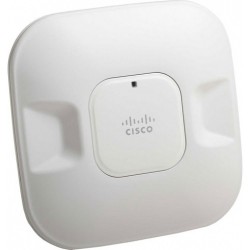Wireless Access Points Online at Low Prices in UAE - Aruba, Cisco
What is an Access Point?
An access point (AP) is a device that enables wireless devices, such as laptops, smartphones, and tablets, to connect to a wired network. An access point acts as a central transmitter and receiver of wireless radio signals, allowing wireless devices to communicate with each other and with the wired network.
An access point typically connects to a wired network through an Ethernet cable and uses wireless radio frequencies to communicate with wireless devices within its coverage area. Access points are commonly used in environments such as offices, homes, schools, and public areas, where wireless connectivity is required for mobile devices.
Access points can be standalone devices or integrated into routers or other network infrastructure devices. They can also support different wireless standards, such as Wi-Fi, Bluetooth, or ZigBee, depending on the intended use and application.
Why Access Points Are Better for Businesses
Access points are better for businesses for several reasons:
Scalability:
Access points can be easily added or removed from a network, making them a scalable solution for businesses of all sizes. This allows businesses to expand their wireless coverage as needed without having to replace the entire network infrastructure.
Security:
Access points can be configured with strong security protocols, such as WPA2, to ensure that only authorized devices can connect to the network. This is particularly important for businesses that deal with sensitive data or need to comply with industry regulations.
Centralized Management:
Access points can be managed centrally through a network controller or management software, making it easy to configure, monitor, and troubleshoot the network. This can save time and resources for IT staff and ensure consistent network performance.
High Performance:
Access points are designed to handle high-traffic volumes and provide reliable, high-speed wireless connectivity. This is particularly important for businesses that rely on wireless networks for mission-critical applications such as video conferencing, cloud-based applications, and file sharing.
Flexibility:
Access points can be used in a variety of deployment scenarios, such as indoor and outdoor environments, and can be configured for different use cases, such as guest access, employee access, and IoT device connectivity.
Overall, access points provide a robust and flexible solution for businesses that require reliable and secure wireless connectivity for their employees, customers, and devices.
Top Selling Wifi Access Point Routers List in India
| Latest Models |
| TP-Link Omada Gigabit VPN Router, ER605 |
| TP-Link EAP225 AC1200 Wireless MU-MIMO Gigabit Indoor/Outdoor Access Point |
| TP-Link AC1750 Wireless Dual Band Gigabit Ceiling Mount Access Point, EAP245 |
| TP-Link AC1350 Wireless MU-MIMO Gigabit Ceiling Mount Access Point, EAP225 |
| COFE CF-4G707 300Mbps 4G SIM-Based Pocket Router with Wi-Fi |
| D-Link DWR-920V N300 Wireless Black 4G LTE Router |
| D-Link N300 300Mbps Wireless Wi-Fi Router with 3 Years Warranty, DIR-650IN |
| D-Link 300 Mbps Wireless Black Router, DIR615 |
| TP-Link Outdoor 300 Mbps Wireless N Outdoor Access Point Router, EAP110 |
Advantages of Using Wireless Access Points
There are several advantages of using wireless access points:
Mobility:
Wireless access points enable mobility by allowing users to access the network from anywhere within the coverage area. This is particularly useful in environments such as offices, hotels, and public spaces, where users need to move around and stay connected.
Convenience:
Wireless access points eliminate the need for cables, making it easy to connect devices to the network. This is particularly useful for mobile devices such as laptops, smartphones, and tablets.
Cost-effectiveness:
Wireless access points are often more cost-effective than wired networks, as they eliminate the need for cabling and can be easily scaled up or down as needed.
Flexibility:
Wireless access points can be placed in a variety of locations, allowing for greater flexibility in network design and deployment. This is particularly useful in environments with complex layouts or where wired connections are not feasible.
Easy to install and configure:
Wireless access points are easy to install and configure, making it easy to add new devices or expand the network as needed. This can save time and resources for IT staff and allow for more efficient network management.
Overall, wireless access points provide a convenient, cost-effective, and flexible solution for businesses and organizations that require reliable wireless connectivity.
Common types of access point configurations
There are several common types of access point configurations, including:
Standalone Access Points:
Standalone access points are single devices that operate independently and do not require a central controller. These types of access points are typically used in small networks with fewer access points.
Controller-Based Access Points:
Controller-based access points are part of a larger network that is managed by a central controller. The controller manages the configuration, monitoring, and troubleshooting of the access points, providing a more centralized and streamlined network management approach. These types of access points are commonly used in larger networks with multiple access points.
Cloud-Managed Access Points:
Cloud-managed access points are managed through a cloud-based controller, allowing for remote management and monitoring of the network. This approach eliminates the need for an on-premises controller and can be useful for distributed networks with multiple locations.
Mesh Access Points:
Mesh access points use a mesh network topology to provide wireless coverage across a larger area. Mesh networks are made up of multiple access points that communicate with each other to provide seamless coverage without the need for cables or wires.
Outdoor Access Points:
Outdoor access points are designed to withstand harsh weather conditions and provide wireless coverage in outdoor environments. These types of access points are commonly used in public areas, parks, and outdoor events.
Overall, the type of access point configuration that is best suited for a particular network depends on factors such as the size and complexity of the network, the number of access points required, and the type of environment in which the network will be deployed.
Conclusion
Access points play a critical role in providing wireless connectivity in various environments, including businesses, homes, schools, and public spaces. They enable wireless devices to connect to a wired network and communicate with each other. Access points can be standalone devices, integrated into routers or other network infrastructure devices, and support different wireless standards.
Using wireless access points provides several advantages, including mobility, convenience, cost-effectiveness, flexibility, and ease of installation and configuration. Common access point configurations include standalone access points, controller-based access points, cloud-managed access points, mesh access points, and outdoor access points. The choice of access point configuration depends on the size and complexity of the network, the number of access points required, and the environment in which the network will be deployed.
An access point is used to provide wireless connectivity to devices such as laptops, smartphones, and tablets. It connects to a wired network and enables wireless devices to communicate with each other and access the network.
A wireless access point is a networking device that enables wireless devices to connect to a wired network. It transmits and receives wireless signals and provides wireless coverage to a specific area, allowing devices to access the network and communicate with each other wirelessly.
Yes, you can use a router as an access point. To do this, you need to disable the router's DHCP server and assign it a static IP address within the range of your existing network. You can then connect the router to your network using an Ethernet cable and configure it to act as an access point. However, it is important to note that using a router as an access point may limit its functionality compared to a dedicated access point, as routers may not support advanced features such as seamless roaming and load balancing.












